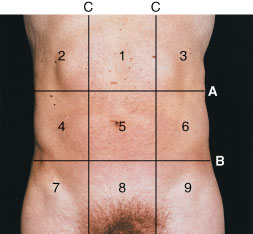The part of the trunk that lies between the thorax and the pelvis. The a. does not include the vertebral region posteriorly but is considered by some anatomists to include the pelvis (abdominopelvic cavity). It includes the greater part of the abdominal cavity (cavitas abdominis [TA]), and is divided by arbitrary planes into nine regions. SEE ALSO: abdominal regions, under region. SYN: venter (1) [TA]. [L. a., etym. uncertain]
- acute a. any serious acute intra-abdominal condition (such as appendicitis) attended by pain, tenderness, and muscular rigidity, and for which emergency surgery must be considered. SYN: surgical a..
- protuberant a. unusual or prominent convexity of the a., due to excessive subcutaneous fat, poor muscle tone, or an increase in intraabdominal content.
- scaphoid a. a condition in which the anterior abdominal wall is sunken and presents a concave rather than a convex contour. SYN: navicular a..
* * *
ab·do·men 'ab-də-mən, -.dō-; əb-'dō-mən, ab- n
1 a) the part of the body between the thorax and the pelvis with the exception of the back called also belly
b) the cavity of this part of the trunk lined by the peritoneum, enclosed by the body walls, the diaphragm, and the pelvic floor, and containing the visceral organs (as the stomach, intestines, and liver)
c) the portion of this cavity between the diaphragm and the brim of the pelvis compare PELVIC CAVITY
2) the posterior often elongated region of the body behind the thorax in arthropods
* * *
n.
the part of the body cavity below the chest (see thorax), from which it is separated by the diaphragm. The abdomen contains the organs of digestion - stomach, liver, intestines, etc. - and excretion - kidneys, bladder, etc.; in women it also contains the ovaries and uterus.
• abdominal adj.
* * *
ab·do·men (abґdə-mən) (ab-doґmən) [L., possibly from abdere to hide] [TA] that portion of the body which lies between the thorax and the pelvis; it contains a cavity (abdominal cavity) separated by the diaphragm from the thoracic cavity above and by the plane of the pelvic inlet from the pelvic cavity below and lined with a serous membrane, the peritoneum. This cavity contains the abdominal viscera (see Plate 50) and is enclosed by a wall (abdominal wall) formed by the abdominal muscles, the vertebral column, and the ilia. Called also belly and venter. It is divided into nine regions by four imaginary lines projected onto the anterior wall (see illustration); two of the lines pass horizontally around the body (the upper at the level of the cartilages of the ninth ribs, the lower at the tops of the crests of the ilia), and two extend vertically on each side of the body from the cartilage of the eighth rib to the center of the inguinal ligament. The regions are: three upper—right hypochondrium, epigastric region, left hypochondrium; three middle—right flank (right lateral region), umbilicus, left flank (left lateral region); and three lower—right groin (right inguinal region), pubic region, left flank (left inguinal region).
 Regions of abdomen: 1, epigastric region; 2, right hypochondrium; 3, left hypochondrium; 4, right flank; 5, umbilicus; 6, left flank; 7, right groin; 8, pubic region; 9, left flank. A, transpyloric plane; B, transtubercular plane; C, midclavicular line.
Regions of abdomen: 1, epigastric region; 2, right hypochondrium; 3, left hypochondrium; 4, right flank; 5, umbilicus; 6, left flank; 7, right groin; 8, pubic region; 9, left flank. A, transpyloric plane; B, transtubercular plane; C, midclavicular line.
Medical dictionary. 2011.